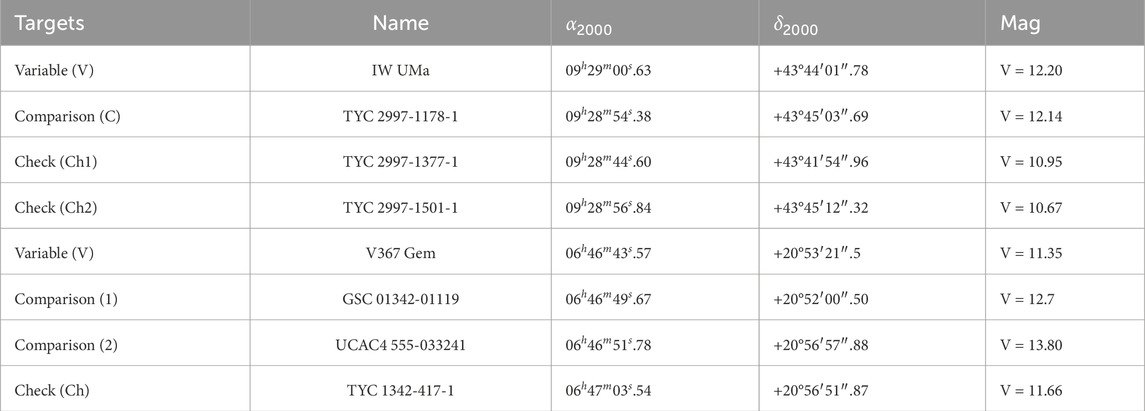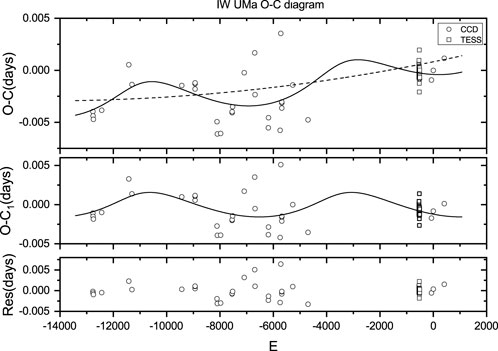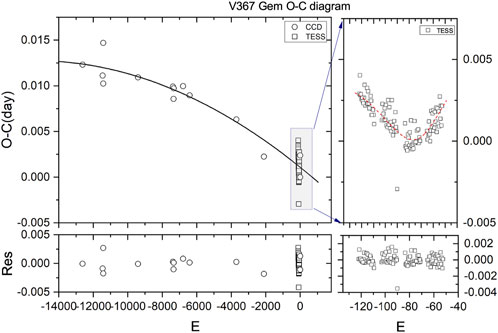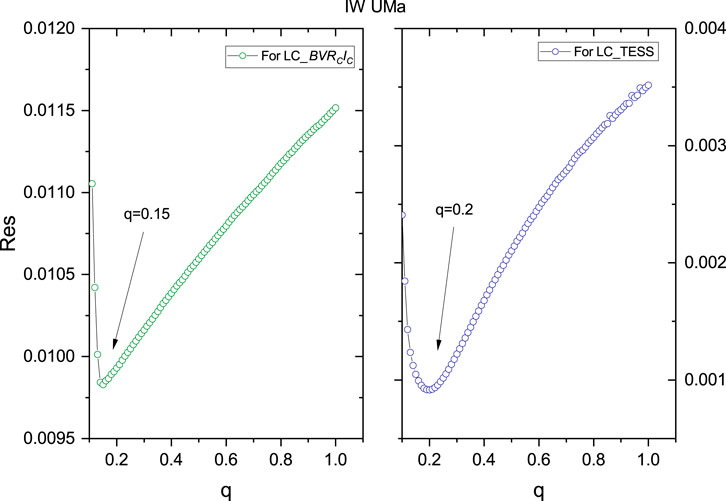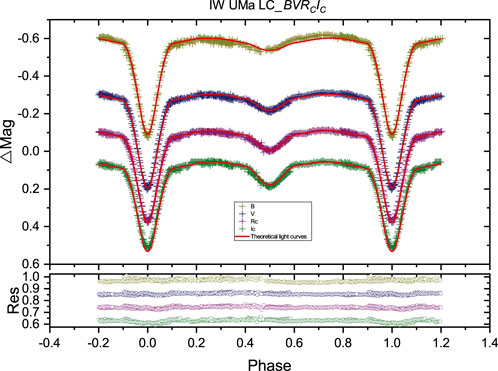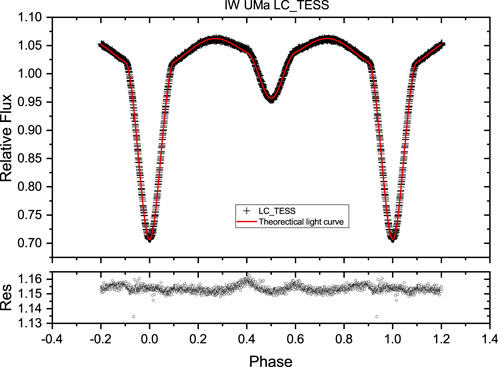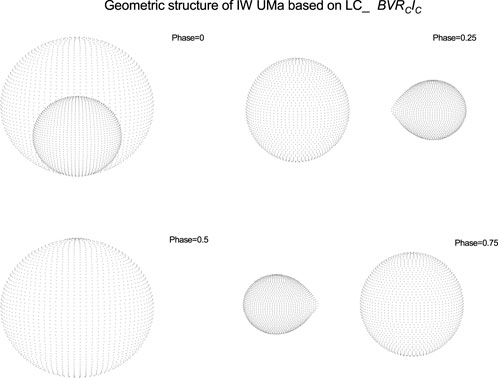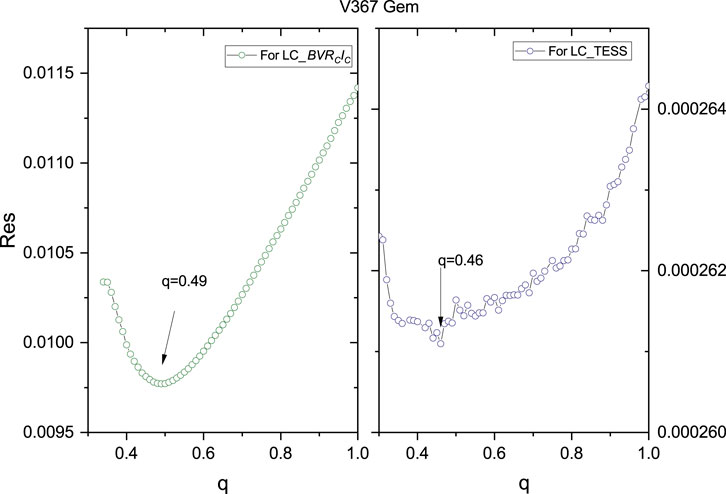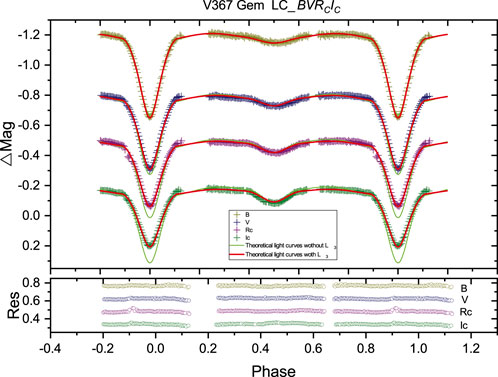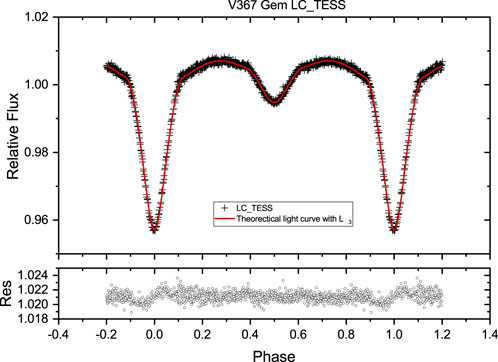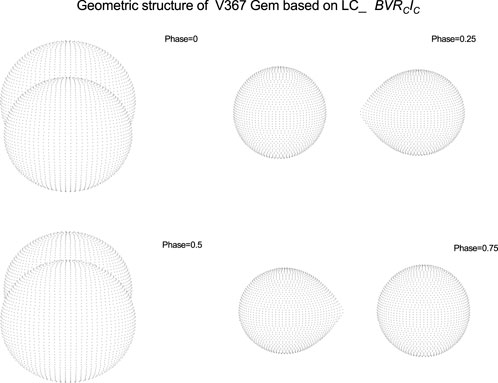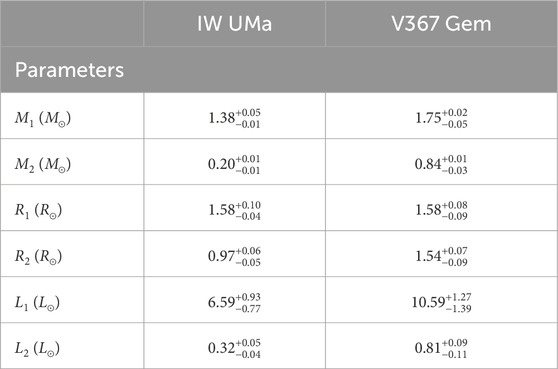- 1School of Aeronautics, Shandong Jiaotong University, Jinan, China
- 2School of Science, Leshan Normal University, Leshan, China
- 3School of Mathematics and Information Sciences, Yantai University, Yantai, China
- 4School of Science and Art, China University of Petroleum-Beijing at Karamay, Karamay, China
Introduction: The first multi-color photometric observations and low-resolution spectra of the Algol-type short-period eclipsing binary systems IWUMa and V367 Gem are presented here. The stellar atmospheric parameters of the primary stars were derived through spectral analysis. Ground-based and TESS-based light curves were analyzed.
Methods: ULySS software was employed to obtain atmospheric parameters by fitting full spectra with model spectra. Wilson–Devinney code was used to analyze the light curves.
Results: The photometric solutions suggest that IW UMa and V367 Gem are both typical Algol systems in a semidetached configuration, with secondary stars filling their Roche lobes. The mass ratios of IW UMa and V367 Gem are 0.145 (3) and 0.478 (15), respectively. A third light was detected in the light curve analysis of V367 Gem with a luminosity contribution of
Discussion: The period decrease of V367 Gem may be due to the mass and angular momentum loss from the system. Additionally, a probable cyclic variation has been identified for the period of V367 Gem, which may be caused by the third body.
1 Introduction
Algol-type binaries are a unique subset of semi-detached eclipsing binaries (EB systems) characterized by mass transfer between their components, which significantly influences their evolution. In these systems, the more luminous and massive component, referred to as the “primary”, is typically composed of B-, A-, or F-type stars. The less luminous and less massive “secondary” component may be an evolved giant or subgiant star. In these systems, the primary component is a main sequence star, while the secondary component fills its Roche lobe, leading to mass transfer from the secondary to the primary. These systems began as binary systems with unequal masses. The more massive component (the future secondary) evolved from the main sequence more quickly than the less massive component (the future primary). When the former primary fills its Roche lobe, a significant mass-transfer episode occurs during which a substantial amount of mass from the former primary is transferred to the less massive component, causing it to become more massive than the Roche-lobe-filling star (the former more massive component). Therefore, current Algols are systems undergoing slow mass transfer from a Roche-lobe-filling giant or subgiant low-mass star (the former massive star) to a main sequence, massive, mass-accreting component (the current primary). The mass transfer results in an increase in the orbital period. Secondary components with later spectral types are magnetically active, producing features such as spots, plages, flares, and winds (e.g., Hall, 1989). These systems lose angular momentum due to magnetic stellar winds, suggesting that mass transfer between the components should be non-conservative (e.g., Sarna et al., 1997; 1998). The observed period decrease in the orbital periods may be attributed to mass loss and transfer and angular momentum loss (AML) (Qian, 2000; 2001; Yang and Wei, 2009; Erdem et al., 2010; Soydugan et al., 2011; Ibanoǧlu et al., 2006). In addition, a magnetic braking mechanism is often referenced to explain the observed orbital shrinkage. Chen et al. (2006) suggested that, in addition to magnetic braking, a circumbinary disk may play an important role in AML from Algol-type binaries, which could explain the low-mass ratio systems undergoing rapid mass transfer.
IW UMa (ASASSN-V J064643.50 + 205322.1) is a confirmed Algol-type variable binary with a short orbital period of 0.7747182 (1) d (Kreiner, 2004). IW UMa was identified as eclipsing Am binary candidates by confirming the relationship between different spectral types, based on the low-resolution spectra of the Large Sky Area Multi
V367 Gem (SVS 863, ASASSN-V J092900.54 + 434402.7) is an Algol-type variable binary with a short orbital period of 0.699229 (1) d as revised by Hintz and Brown (2007). V367 Gem was also identified as eclipsing Am binary candidates with an MK spectral type of the primary component classified as kA3hA5mA7 by Tian et al. (2023). Hintz and Brown (2007) also released the light curves and found some minimal color changes with values of (B
In this study, we obtain the multi-color high-precision light curves and low-resolution spectra of both targets. Based on the times of the light minimum collected and calculated from the TESS database, the O
2 Observation and data reduction
2.1 Photometric observations
The new complete multi-color light curves of IW UMa in Johnson
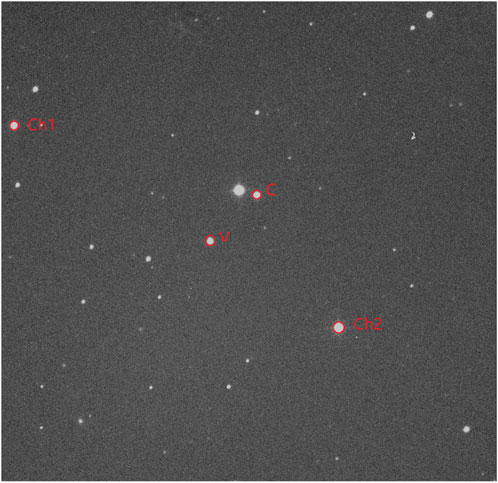
Figure 1. CCD image of IW UMa in the
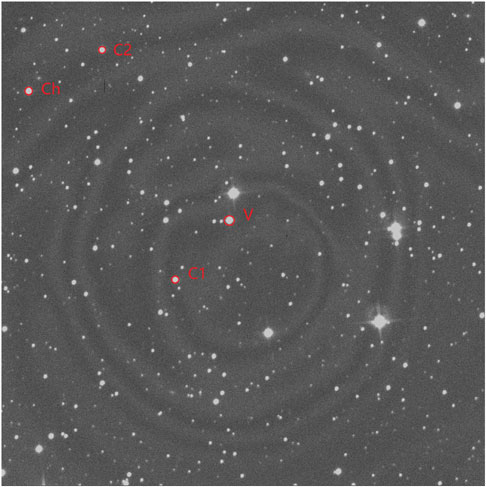
Figure 2. CCD image of V367 Gem in the
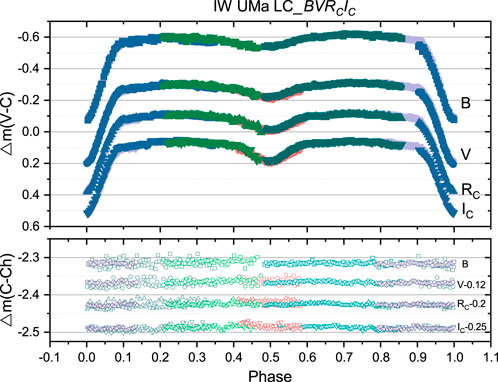
Figure 3. Light curves of IW UMa in the
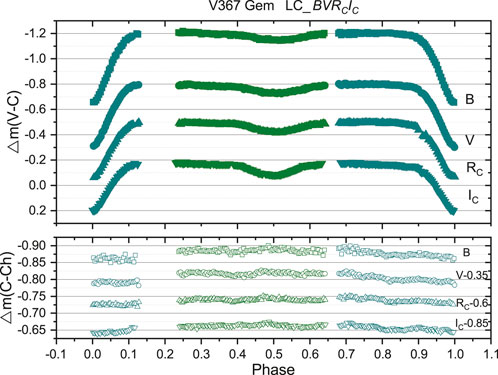
Figure 4. Light curves of V367 Gem in the
2.2 TESS observations
The Transiting Exoplanet Survey Satellite (TESS) is an all-sky transit survey whose principal goal is to detect Earth-sized planets orbiting bright stars that are amenable to follow-up observations to determine planet masses and atmospheric compositions (Ricker et al., 2014). These targets are read out as postage stamps and made available to the community as target pixel files (TPFs) and corrected light curves. These files comprise several time series, including a simple aperture photometry, a corrected light curve, position vectors, and quality flags. The aperture photometry flux series is termed “SAP_FLUX”, while the flux series that has the common instrumental systematics removed using cotrending basis vectors (CBV) files is termed “PDCSAP_FLUX”. SAP_Flux was used to obtain the light curves of IW UMa and V367 Gem in this study.
IW UMa (TESS target identifier: TIC 105439439) and V367 Gem (TESS target identifier: TIC 56897408) have been observed by TESS for many days in different sectors. The data were retrieved using the Python package
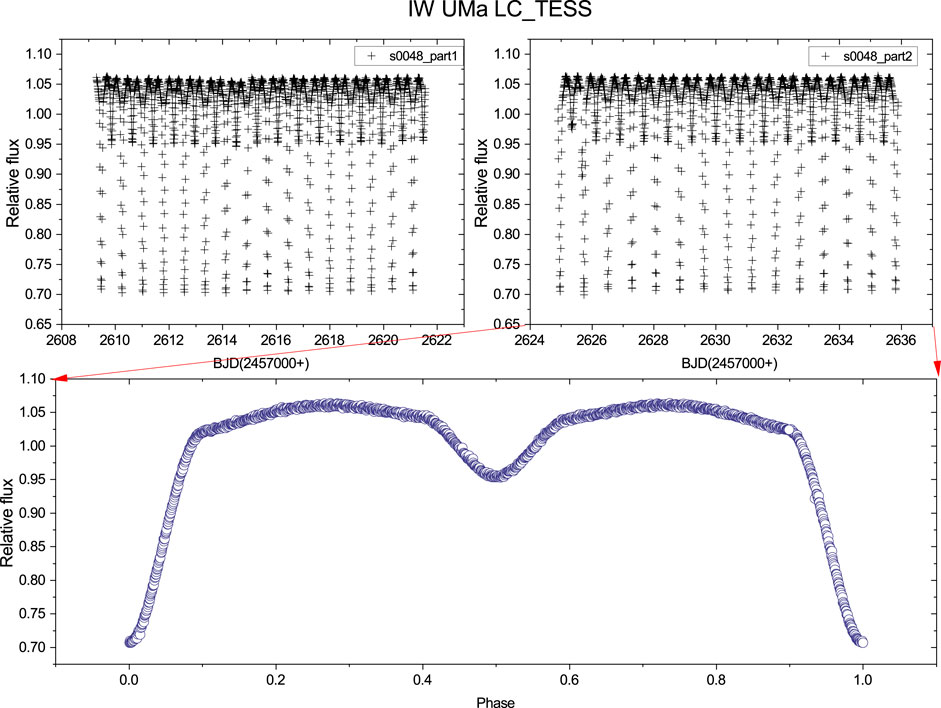
Figure 5. Continuous time-series and phase-binned light curves of IW UMa obtained from the TESS database. Top panels show the continuous time-series light curves from sector 48. The phase-binned light curve is shown in the bottom panel calculated from the light curves shown in the top-right panel.
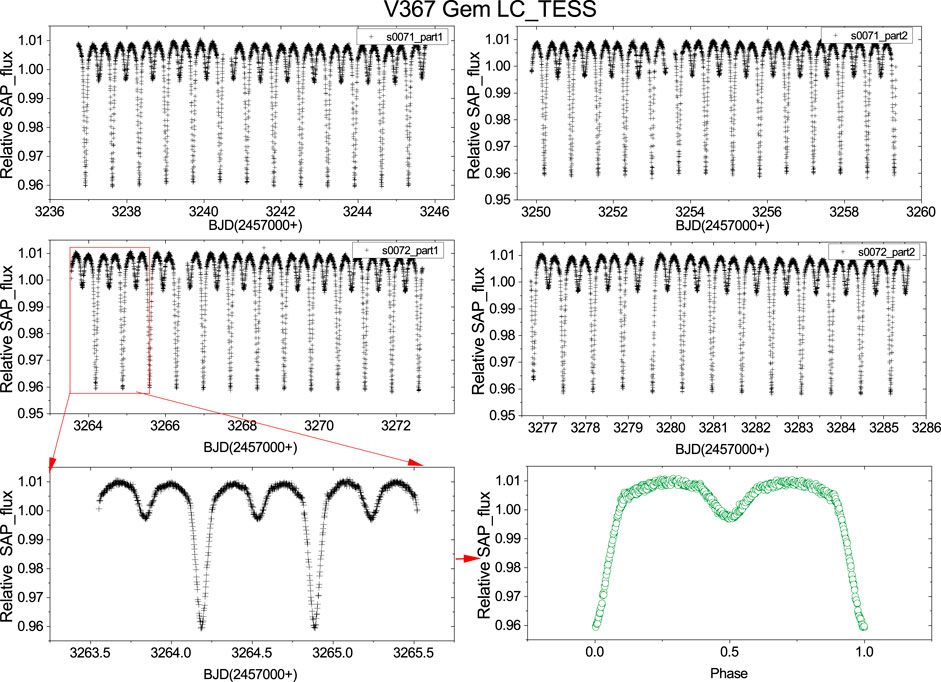
Figure 6. Continuous time-series and phase-binned light curves of V367 Gem obtained from the TESS database. The top and middle panels display the continuous time-series light curves from sector 71 and 72, respectively. The bottom-left panel presents the partial light curves highlighted in the middle-left panel. Finally, the phase-binned light curve derived from these partial light curves is illustrated in the bottom-right panel.
2.3 Spectroscopic observations
The spectra of IW UMa and V367 Gem were observed using the Beijing Faint Object Spectrograph and Camera (BFOSC), which was mounted on the 2.16 m telescope of the Xinglong station of the National Astronomical Observatories of China (NAOC), Chinese Academy of Sciences (CAS). The observations were made on 14 January 2023, using a low-dispersion spectrometer BFOSC and grism G6. The slit width and line dispersion of grism G6 are 1.8 arcsec and 88 Å
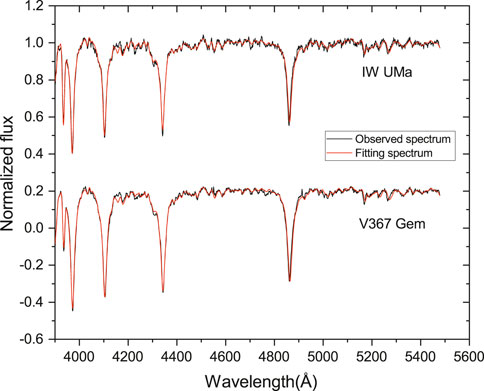
Figure 7. Spectra of IW UMa and V367 Gem observed on 14 January 2023. The black and red lines represent the observed and fitting spectrum, respectively.
University of Lyon Spectroscopic Analysis Software (ULySS) (Koleva et al., 2009) was employed to obtain atmospheric parameters by fitting full spectra with model spectra generated by an interpolator with the ELODIE library (Prugniel and Soubiran, 2001).
The red lines in Figure 8 represent the fitting spectra. The atmospheric stellar parameters were derived—for IW UMa:
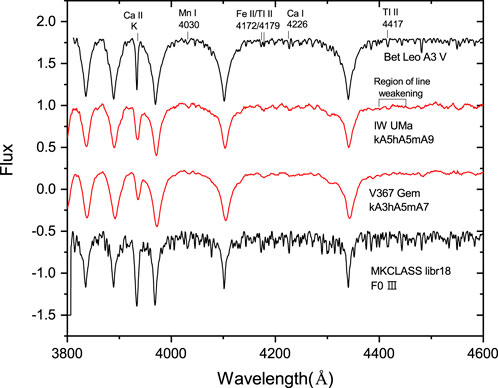
Figure 8. Comparison of the blue–violet spectrum (3800–4600 Å) of IW UMa and V367 Gem with the part of the spectrum of two MK standards.
The physical properties of the primary can be estimated from the atmosphere parameters by matching with stellar isochrones for normal single stars, assuming that the mass-accreting component is in thermal equilibrium (Zhang et al., 2019), using the PARSEC (Padova and Trieste Stellar Evolution Code) isochrone database (Bressan et al., 2012; Chen et al., 2014; 2015; Tang et al., 2014) along with the lognormal form initial mass function by Chabrier (2001). The primary stars’ physical properties can then be determined, including mass and radius—for IW UMa:
The blue-violet spectrum (3800–4600 Å) of IW UMa, V367 Gem, and part of the spectrum of two MK standard spectra with a type of A3 V (Bet Leo) and F0 III are shown in Figure 8. It is clear that the Ca II K lines of IW UMa and V367 Gem are quite weaker in strength than that of the A3 and F0 MK standards, which exhibit typical characteristics similar to Am stars. The low resolution of the spectral data means that many metallic properties are not adequately captured. Indeed, the Am classification of the primary components of Algol undergoing mass accretion and experiencing high atmospheric turbulence dynamics contradicts the theories of Am star formation. The accurate determination of chemical composition should be based on multi-element chemical composition analysis conducted through high-resolution spectroscopy.
3 O
All available light minimum times of IW UMa and V367 Gem were collected from the literature. Meanwhile, we computed the light minima based on the TESS data for both targets in HJD time—listed in the Appendix of Supplementary Tables A1 and B1 marked “This study*” in the corresponding reference column.
3.1 IW UMa
A total of 95 eclipse times of IW UMa spanning approximately 28 years were used to structure the O
In Equation 2, “Min I” are the observed primary eclipse times and 2460030.1425 (2) is the primary eclipse time of the multi-color light curves.
The O
The error associated with the coefficient of the quadratic term is quite large. The black line in Figure 9 represents the fitting curve. We noticed that this parabolic fit is statistically insignificant. The fitting residuals are shown in the middle panel of Figure 9, which may indicate a cyclic variation. The final residuals are shown at the bottom of Figure 9. The period of IW UMa is likely increasing over the long term superposed with cyclic variation. Considering the large fitting error, this conclusion requires further confirmation.
3.2 V367 Gem
For V367 Gem, 117 eclipse times crossing approximately 25 years were used to calculate the O
The O
The quadratic term in the above polymerization indicates that the period is undergoing a long-term decrease at a rate of
in which:
The O
4 Light curve analyses
The Wilson–Devinney (WD) program (Wilson and Devinney, 1971; Wilson, 1990; 2012) was used to analyze all the light curves (including these based on the TESS data) of the two targets. The gravity-darkening coefficients and bolometric albedos were taken according to temperature (Ruciński, 1969). The bandpass limb-darkening coefficients were taken from van Hamme (1993), and the logarithmic bolometric coefficients were applied. There are various modes for different binary configurations in the WD program. We acquired the converged solutions of both targets with Mode 5 (the semidetached case with the secondary component filling the critical RL). The corresponding adjustable parameters of Mode 5 are: the monochromatic luminosity of star 1,
4.1 IW UMa
The first multi-color light curves of IW UMa were observed. The TESS observation data from sector 48 (covering HJD 2459625 to HJD 2459636) were utilized to generate the light curve for analysis. The light curves are shown at the bottom of Figure 5. In the figures below, the observed multi-color light curve is labeled “LC_
in which the epoch 2460030.14246 (12) is the new observed eclipse time and 2459625.73832 (168) is the eclipse time based on the TESS database.
The effective temperature of the primary star obtained as
4.2 V367 Gem
The first multi-color light curves of V367 Gem were observed. Different linear ephemeris was used to calculate the phased light curves for the observed multi-color light curves and TESS observation. For multi-color light curves, the ephemeris given by Equation 3 was used. For the TESS-based light curves, the linear ephemeris Equation 7 was used:
in which the epoch 2460322.22210 (25) is the new observed eclipse times and 2460264.18578 (8) is the eclipse times based on the TESS data.
In the WD modeling, the effective temperature of the primary star was fixed at 8280 K, which was obtained from our spectral analysis. The convergent solutions were confirmed with Mode 5. The third light
5 Discussion and conclusion
The atmospheric parameters of the primary components of the Algol-like short-period eclipsing Am binaries IW UMa and V367 Gem are obtained based on the spectra analyses: for IW UMa,
All available eclipse times were used to investigate the variations of the orbital period by analyzing the O
IW UMa and V367 Gem are typical Algol systems in a semidetached phase with the secondary star filling the RL. The period increase of IW UMa may be the cause of the mass transfer from the secondary to the primary star (e.g., Qian, 2002; Tian and Zhu, 2019). The period decrease of V367 Gem may mainly be caused by the mass and angular momentum loss (AML) via an enhanced stellar wind of the more evolved secondary star (e.g., Tout and Eggleton, 1988; Liao et al., 2017; 2019). The probable cyclic variation may be caused by the magnetic activity of one or both components (Applegate, 1992) and the light travel time effect (LTTE) through the presence of a tertiary companion. In light curve analysis, the detection of a third light may indicate the existence of a distant companion, which could plausibly explain the cyclic variation observed in V367 Gem due to LTTE. The third body plays an important role in the evolution of the binaries; it will cause the cyclic variation of an orbital period and also will take away the angular momentum of the system, leading to the orbital contraction process and then promoting the evolution of contact binaries (Tokovinin et al., 2006; Qian et al., 2013a; 2014b; 2017). Both targets are in a semidetached configuration, with the secondary star filling the RL, and then will evolve into a marginal-contact phase with poor thermal contact (e.g., Liao et al., 2012; Qian et al., 2013b; 2014a; Liao and Sarotsakulchai 2019), such as GW Gem and V723 Per (Tian and Zhu, 2019).
The components in very-short-period near-contact systems are likely to be rotating synchronously. For a circular orbit, the following equation can be used to obtain the equatorial rotational velocity
The spectra types and temperature of primary stars in IW UMa and V367 Gem indicate that both systems are AF-type Algols, with primary components classified as A- or F- type stars. We combined our two targets with the AF-type Algols collected by Wang et al. (2022) to investigate the evolutionary stages of these systems. The distributions of a Hertzsprung–Russell (HR) diagram are illustrated in Figure 19. Different symbols are used to differentiate AF-type Algols from our target stars, while various colors indicate the primary and secondary components. The primary components of AF-type Algol systems are predominantly located near the zero-age main sequence, whereas nearly all secondary components have evolved away from the main sequence. The mass-luminosity (M-L) relation, mass-radius (M-R) relation, and mass-temperature (M-T) relation of the components are shown in Figure 20. Different symbols are used to differentiate AF-type Algols and our target stars, and various colors indicate the primary and secondary components, respectively. The blue dash lines indicate the corresponding empirical relationships of main sequence (MS) stars (Eker et al., 2018). The primary components of AF-type Algols closely follow the empirical relationships of main sequence stars. In contrast, the secondary components are brighter, larger, and a little hotter than MS stars of the same mass.
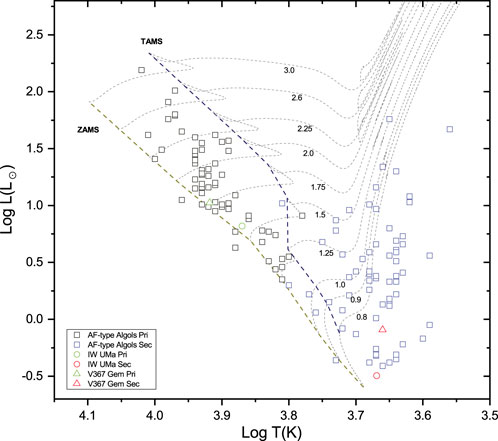
Figure 19. Hertzsprung–Russell diagram of AF-type Algols including IW UMa and V367 Gem. The evolutionary tracks (thin dash lines) for the labeled masses, as well as the zero-age main sequence (ZAMS) and the terminal-age main sequence (TAMS), were taken from Bressan et al. (2012), which were calculated for Y = 0.279, Z = 0.017.
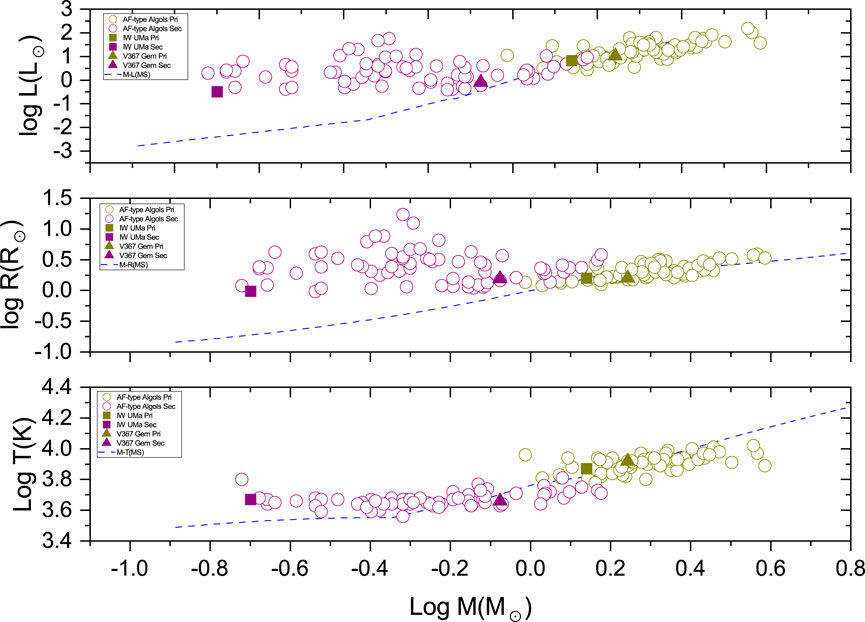
Figure 20. M-R, M-L, and M-T distributions of AF-type Algols including IW UMa and V367 Gem. The blue dash-lines represent the corresponding empirical relationships of main sequence stars (Eker et al., 2018).
We noticed that the primary components contribute about
Data availability statement
The original contributions presented in the study are included in the article/Supplementary Material; further inquiries can be directed to the corresponding author.
Author contributions
X-MT: conceptualization, formal analysis, funding acquisition, investigation, methodology, software, writing–original draft, and writing–review and editing. L-QJ: data curation, methodology, resources, visualization, and writing–review and editing. Z-HW: formal analysis, funding acquisition, resources, supervision, and writing–review and editing. J-JW: funding acquisition, investigation, methodology, project administration, validation, and writing–review and editing.
Funding
The authors declare that financial support was received for the research, authorship, and/or publication of this article. This work is supported by the National Natural Science Foundation of China (Grant Nos. 12103030 and 12303038), the Natural Science of Shandong Province (Grant No. ZR2021QA082), the Natural Science Foundation of Xinjiang Uygur Autonomous Region (Grant No. 2022DO1A164), the Joint Research Found (Grant No. U1831109) in Astronomy under cooperative agreement between the National Science Foundation of China (NSFC) and Chinese Academy of Sciences (CAS), and the Young Talent Project of the Yunnan Revitalization Talent Support Program and the CAS Light of West China Program. This work is partly supported by the Research Fund of the Key Laboratory of Aircraft Environment Control and Life Support, MIIT, Nanjing University of Aeronautics and Astronautics (Grant No. KLAECLS–E–202203).
Acknowledgments
We acknowledge the support of the staff of the Xinglong 80 cm and the Xinglong 2.16 m telescopes. This research was partially supported by the Open Project Program of the Key Laboratory of Optical Astronomy, National Astronomical Observatories, Chinese Academy of Sciences. This paper has used data collected by the Transiting Exoplanet Survey Satellite (TESS) mission, for which funding is provided by the NASA Explorer Program. We would like to thank the editor and the referees for the very valuable and useful comments that helped improve this paper.
Conflict of interest
The authors declare that the research was conducted in the absence of any commercial or financial relationships that could be construed as a potential conflict of interest.
Publisher’s note
All claims expressed in this article are solely those of the authors and do not necessarily represent those of their affiliated organizations, or those of the publisher, the editors and the reviewers. Any product that may be evaluated in this article, or claim that may be made by its manufacturer, is not guaranteed or endorsed by the publisher.
Supplementary material
The Supplementary Material for this article can be found online at: https://www.frontiersin.org/articles/10.3389/fspas.2024.1497989/full#supplementary-material
References
Applegate, J. H. (1992). A mechanism for orbital period modulation in close binaries. Astrophysical J. 385, 621. doi:10.1086/170967
Ažusienis, A., and Straižys, V. (1969). Improved determination of the response curves and parameters of the UBV system. Summary of results. Sov. Astron. 13, 316.
Bessell, M. S. (1983). VRI photometry: an addendum. Publ. Astronomical Soc. Pac. 95, 480–488. doi:10.1086/131196
Borovicka, J., and Sarounova, L. (1996). The Period and lightcurve of NSV 4497. Inf. Bull. Var. Stars 4402, 1.
Bressan, A., Marigo, P., Girardi, L., Salasnich, B., Dal Cero, C., Rubele, S., et al. (2012). PARSEC: stellar tracks and isochrones with the PAdova and TRieste Stellar Evolution Code. Mon. Notices R. Astronomical Soc. 427, 127–145. doi:10.1111/j.1365-2966.2012.21948.x
Carquillat, J. M., and Prieur, J. L. (2007). Contribution to the search for binaries among Am stars - VIII. New spectroscopic orbits of eight systems and statistical study of a sample of 91 Am stars. Mon. Notices R. Astronomical Soc. 380, 1064–1078. doi:10.1111/j.1365-2966.2007.12143.x
Chabrier, G. (2001). The galactic disk mass budget. I. Stellar mass function and density. Astrophysical J. 554, 1274–1281. doi:10.1086/321401
Chen, W.-C., Li, X.-D., and Qian, S.-B. (2006). Orbital evolution of Algol binaries with a circumbinary disk. Astrophysical J. 649, 973–978. doi:10.1086/506433
Chen, Y., Bressan, A., Girardi, L., Marigo, P., Kong, X., and Lanza, A. (2015). PARSEC evolutionary tracks of massive stars up to 350 M⊙ at metallicities 0.0001 ≤ Z ≤ 0.04. Mon. Notices R. Astronomical Soc. 452, 1068–1080. doi:10.1093/mnras/stv1281
Chen, Y., Girardi, L., Bressan, A., Marigo, P., Barbieri, M., and Kong, X. (2014). Improving PARSEC models for very low mass stars. Mon. Notices R. Astronomical Soc. 444, 2525–2543. doi:10.1093/mnras/stu1605
Eker, Z., Bakış, V., Bilir, S., Soydugan, F., Steer, I., Soydugan, E., et al. (2018). Interrelated main-sequence mass-luminosity, mass-radius, and mass-effective temperature relations. Mon. Notices R. Astronomical Soc. 479, 5491–5511. doi:10.1093/mnras/sty1834
Erdem, A., Doğru, S. S., Soydugan, F., Çiçek, C., and Demircan, O. (2010). Period studies of five neglected algol-type binaries: RW cet, BO Gem, DG lac, SW oph and WY per. New Astron. 15, 628–636. doi:10.1016/j.newast.2010.02.007
Fan, Z., Wang, H., Jiang, X., Wu, H., Li, H., Huang, Y., et al. (2016). The Xinglong 2.16-m telescope: current instruments and scientific projects. Publ. Astronomical Soc. Pac. 128, 115005. doi:10.1088/1538-3873/128/969/115005
Hall, D. S. (1989). The relation between RS CVn and Algol. Space Sci. Rev. 50, 219–233. doi:10.1007/BF00215932
Hintz, E. G., and Brown, P. J. (2007). Revised periods for QS geminorum and V367 geminorum. Publ. Astronomical Soc. Pac. 119, 274–283. doi:10.1086/516602
Ibanoǧlu, C., Soydugan, F., Soydugan, E., and Dervişoǧlu, A. (2006). Angular momentum evolution of Algol binaries. Mon. Notices R. Astronomical Soc. 373, 435–448. doi:10.1111/j.1365-2966.2006.11052.x
Koleva, M., Prugniel, P., Bouchard, A., and Wu, Y. (2009). ULySS: a full spectrum fitting package. Astronomy Astrophysics 501, 1269–1279. doi:10.1051/0004-6361/200811467
Liao, W. P., Qian, S. B., Li, L. J., Zhou, X., Zhao, E. G., and Zhang, J. (2017). DI hya: a near-contact binary with a close-in companion. Publ. Astronomical Soc. Pac. 129, 034201. doi:10.1088/1538-3873/aa5869
Liao, W. P., Qian, S. B., and Liu, N. P. (2012). A CCD photometric study of the contact binary star GSC 03526-01995. Astronomical J. 144, 178. doi:10.1088/0004-6256/144/6/178
Liao, W. P., Qian, S. B., and Sarotsakulchai, T. (2019). Physical properties of the close-in tertiary in the southern triple-lined system VZ lib. Astronomical J. 157, 207. doi:10.3847/1538-3881/ab17d4
Liao, W. P., and Sarotsakulchai, T. (2019). First photometric investigations of the solar-type binary FV CVn in multiple systems. Publ. Astronomical Soc. Pac. 131, 014202. doi:10.1088/1538-3873/aaeae2
Lightkurve Collaboration Cardoso, J. V. D. M., Hedges, C., Gully-Santiago, M., Saunders, N., Cody, A. M., et al. (2018). Lightkurve: kepler and TESS time series analysis in Python. Astrophys. Source Code Libr. Rec. ascl:1812.013.
Prugniel, P., and Soubiran, C. (2001). A database of high and medium-resolution stellar spectra. Astronomy Astrophysics 369, 1048–1057. doi:10.1051/0004-6361:20010163
Qian, S. (2000). Orbital period changes and possible mass and angular momentum loss in two Algol-type binaries: RW Coronae Borealis and TU Herculis. Astronomical J. 119, 901–905. doi:10.1086/301217
Qian, S. (2001). Possible mass and angular momentum loss in algol-type binaries. III. TU cancri, FZ delphini, AY geminorum, VZ leonis, FH orionis, IU persei, XZ persei, and BE vulpeculae. Astronomical J. 121, 1614–1622. doi:10.1086/319404
Qian, S. (2002). Period changes in four algol-type binaries: SX dra, AV del, CU peg and DK peg. Astrophysics Space Sci. 282, 399–409. doi:10.1023/A:1020876723842
Qian, S.-B., He, J.-J., Zhang, J., Zhu, L.-Y., Shi, X.-D., Zhao, E.-G., et al. (2017). Physical properties and catalog of EW-type eclipsing binaries observed by LAMOST. Res. Astronomy Astrophysics 17, 087. doi:10.1088/1674-4527/17/8/87
Qian, S. B., Liu, N. P., Li, K., He, J. J., Zhu, L. Y., Zhao, E. G., et al. (2013a). BI vulpeculae: a siamese twin with two very similar cool stars in shallow contact. Astrophysical J. Suppl. Ser. 209, 13. doi:10.1088/0067-0049/209/1/13
Qian, S. B., Liu, N. P., Liao, W. P., He, J. J., Liu, L., Zhu, L. Y., et al. (2013b). First photometric investigation of the newly discovered W UMa-type binary star MR com. Astronomical J. 146, 38. doi:10.1088/0004-6256/146/2/38
Qian, S. B., Wang, J. J., Zhu, L. Y., Snoonthornthum, B., Wang, L. Z., Zhao, E. G., et al. (2014a). Optical flares and a long-lived dark spot on a cool shallow contact binary. Astrophysical J. Suppl. Ser. 212, 4. doi:10.1088/0067-0049/212/1/4
Qian, S. B., Zhou, X., Zola, S., Zhu, L. Y., Zhao, E. G., Liao, W. P., et al. (2014b). AL cassiopeiae: an F-type contact binary system with a cool stellar companion. Astronomical J. 148, 79. doi:10.1088/0004-6256/148/5/79
Ricker, G. R., Winn, J. N., Vanderspek, R., Latham, D. W., Bakos, G. Á., Bean, J. L., et al. (2014). “Transiting Exoplanet survey satellite (TESS),” in Space telescopes and instrumentation 2014: optical, infrared, and millimeter wave. Editors J. Oschmann, M. Jacobus, M. Clampin, G. G. Fazio, and H. A. MacEwen (Society of Photo-Optical Instrumentation Engineers (SPIE) Conference Series), 9143, 914320
Ruciński, S. M. (1969). The proximity effects in close binary systems. II. The bolometric reflection effect for stars with deep convective envelopes. Acta Astron. 19, 245.
Sarna, M. J., Muslimov, A., and Yerli, S. K. (1997). Magnetic activity and evolution of Algol-type stars. Mon. Notices R. Astronomical Soc. 286, 209–214. doi:10.1093/mnras/286.1.209
Sarna, M. J., Yerli, S. K., and Muslimov, A. G. (1998). Magnetic activity and evolution of Algol-type stars - II. Mon. Notices R. Astronomical Soc. 297, 760–768. doi:10.1046/j.1365-8711.1998.01539.x
Soydugan, F., Erdem, A., Doğru, S. S., Aliçavuş, F., Soydugan, E., Çiçek, C., et al. (2011). Period studies of classical algol-type binaries II: UX Leo, RW Mon, EQ ori, XZ UMa and AX vul. New Astron. 16, 253–264. doi:10.1016/j.newast.2010.11.006
Tang, J., Bressan, A., Rosenfield, P., Slemer, A., Marigo, P., Girardi, L., et al. (2014). New PARSEC evolutionary tracks of massive stars at low metallicity: testing canonical stellar evolution in nearby star-forming dwarf galaxies. Mon. Notices R. Astronomical Soc. 445, 4287–4305. doi:10.1093/mnras/stu2029
Tian, X.-M., Wang, Z.-H., Zhu, L.-Y., and Yang, X.-L. (2023). A new catalog of Am-type chemically peculiar stars based on LAMOST. Astrophysical J. Suppl. Ser. 266, 14. doi:10.3847/1538-4365/acc4b5
Tian, X.-M., and Zhu, L.-Y. (2019). V723 Persei: a short-period Algol-like near-contact binary. Publ. Astronomical Soc. Jpn. 71, 66. doi:10.1093/pasj/psz044
Tokovinin, A., Thomas, S., Sterzik, M., and Udry, S. (2006). Tertiary companions to close spectroscopic binaries. Astronomy Astrophysics 450, 681–693. doi:10.1051/0004-6361:20054427
Tout, C. A., and Eggleton, P. P. (1988). Tidal enhancement by a binary companion of stellar winds from cool giants. Mon. Notices R. Astronomical Soc. 231, 823–831. doi:10.1093/mnras/231.4.823
van Hamme, W. (1993). New limb-darkening coefficients for modeling binary star light curves. Astronomical J. 106, 2096. doi:10.1086/116788
Wang, Z. H., Zhu, L. Y., and Yue, Y. F. (2022). Evolutionary inference and statistical constraints on Algols including SD2-type near contact binaries. Mon. Notices R. Astronomical Soc. 511, 488–500. doi:10.1093/mnras/stac037
Wilson, R. E. (1990). Accuracy and efficiency in the binary star reflection effect. Astrophysical J. 356, 613. doi:10.1086/168867
Wilson, R. E. (2012). Spotted star light curves with enhanced precision. Astronomical J. 144, 73. doi:10.1088/0004-6256/144/3/73
Wilson, R. E., and Devinney, E. J. (1971). Realization of accurate close-binary light curves: application to MR cygni. Astrophysical J. 166, 605. doi:10.1086/150986
Yang, Y. G., and Wei, J. Y. (2009). Evolutionary status of RV trianguli and its related algol-type binaries. Astronomical J. 137, 226–235. doi:10.1088/0004-6256/137/1/226
Keywords: eclipsing binary, Algol, light curve, period analysis, evolution
Citation: Tian X-M, Jiang L-Q, Wang Z-H and Wang J-J (2025) The first photometric investigation of two short-period Algol-type eclipsing binaries: IW UMa and V367 Gem. Front. Astron. Space Sci. 11:1497989. doi: 10.3389/fspas.2024.1497989
Received: 18 September 2024; Accepted: 03 December 2024;
Published: 09 January 2025.
Edited by:
Marcella Marconi, Astronomical Observatory of Capodimonte (INAF), ItalyReviewed by:
Andrzej S. Baran, Missouri State University, United StatesMkrtichian Egishe David, National Astronomical Research Institute of Thailand, Thailand
Copyright © 2025 Tian, Jiang, Wang and Wang. This is an open-access article distributed under the terms of the Creative Commons Attribution License (CC BY). The use, distribution or reproduction in other forums is permitted, provided the original author(s) and the copyright owner(s) are credited and that the original publication in this journal is cited, in accordance with accepted academic practice. No use, distribution or reproduction is permitted which does not comply with these terms.
*Correspondence: Xiao-man Tian, dHhtamx4MjAxOEAxNjMuY29t
 Xiao-Man Tian
Xiao-Man Tian Lin-Qiao Jiang
Lin-Qiao Jiang Zhi-Hua Wang3
Zhi-Hua Wang3